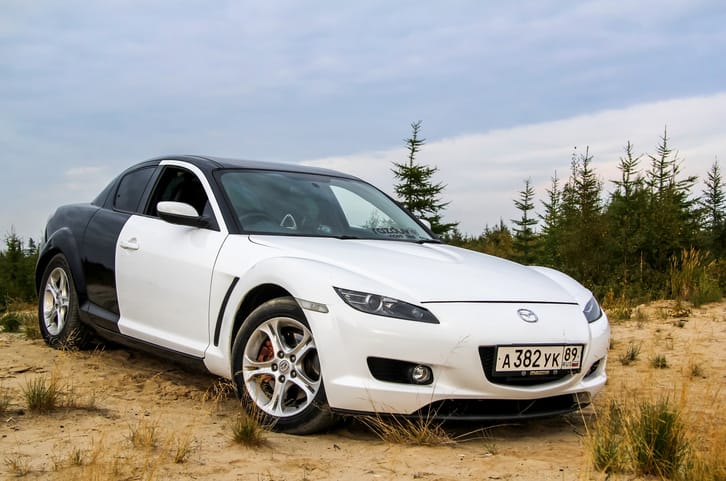The Mazda RX-8: A Rotary Farewell

The Mazda RX-8, a sleek four-door sports car, carved its niche between 2003 and 2012. It succeeded the legendary RX-7, carrying the torch of Mazda's rotary engine technology. This article delves into the RX-8's history, design, performance, and the unique rotary engine that set it apart.
A Rotary Revolution
Mazda had a long and successful history with rotary engines, also known as Wankel engines. Unlike conventional piston engines, a rotary engine uses a triangular rotor spinning within a chamber to create combustion. This design offered several advantages: smoother operation, higher revs for increased power potential, and a more compact size. The RX-8 was the culmination of Mazda's rotary engineering, employing a 1.3L twin-rotor engine in various configurations.

Aesthetics and Design
The RX-8's design was both stylish and functional. The sloping roofline and muscular fenders gave it an aggressive look, while the four suicide doors, inspired by the RX-7, offered easier access to the rear seats. The interior was driver-focused, with a well-bolstered seat and a clean layout for the gauges and controls. The back seats, though cramped for adults, provided surprising utility for occasional passengers or extra cargo space.
Trims and Performance
The RX-8 came in various trims, offering a range of features and performance options. Base models focused on delivering a pure driving experience with a manual transmission and the naturally aspirated rotary engine producing around 230 horsepower. Higher trims like the Grand Touring added features like a sunroof, leather seats, and a Bose sound system. Later models offered a six-speed automatic transmission for those who preferred a more comfortable driving experience.
The RX-8's true appeal lay in its handling. The lightweight chassis and near-perfect 50/50 weight distribution resulted in sharp, responsive steering and a sense of connection between driver and car. The rotary engine, while not known for raw power, provided a smooth and exhilarating ride with its high redline and eagerness to rev.
The Rotary's Achilles Heel
While the rotary engine offered a unique driving experience, it had its drawbacks. One major concern was fuel consumption. Rotaries tend to be less fuel-efficient than piston engines, and the RX-8 was no exception. Additionally, the rotary engine's design made it prone to oil consumption and required specific maintenance procedures to ensure longevity.
Another challenge for the RX-8 was stricter emissions regulations. The rotary engine's combustion process inherently produced more emissions than traditional piston engines. This ultimately led to the RX-8's demise in many markets, including Europe, where it was discontinued in 2010.
Beyond the Engine: A Legacy of Spirit
Despite the challenges, the RX-8 garnered a loyal following. For enthusiasts, the rotary engine's smooth power delivery and the car's exceptional handling created a special driving experience. The RX-8 wasn't just a car; it was a symbol of Mazda's innovative spirit and their commitment to pushing boundaries.

A Farewell to the Rotary?
The RX-8's discontinuation in 2012 marked the end of an era for Mazda's rotary engines. However, rumors persist that Mazda might be developing a new generation rotary engine with improved efficiency and emissions. Whether this translates into a new RX-8 successor or a different application remains to be seen.
Owning a Mazda RX-8 Today
The RX-8 is a compelling option for those seeking a unique and exciting sports car experience. With its used car prices becoming more affordable, it presents an opportunity to own a piece of Mazda's rotary heritage. However, potential buyers should be aware of the rotary engine's specific needs. Finding a well-maintained RX-8 with a documented service history is crucial. Additionally, budgeting for potential maintenance costs associated with the rotary engine is essential for long-term ownership.

The Mazda RX-8: A Sports Car with Soul
The Mazda RX-8 may not have been a mainstream success, but it left a lasting impression on the automotive world. It offered a unique driving experience with its rotary engine and exceptional handling. Even today, it stands as a testament to Mazda's innovative spirit and their dedication to creating cars that are not just machines, but convey a sense of passion and connection with the driver. Whether or not the rotary engine makes a comeback, the RX-8's legacy as a captivating sports car with a soul is sure to endure.
